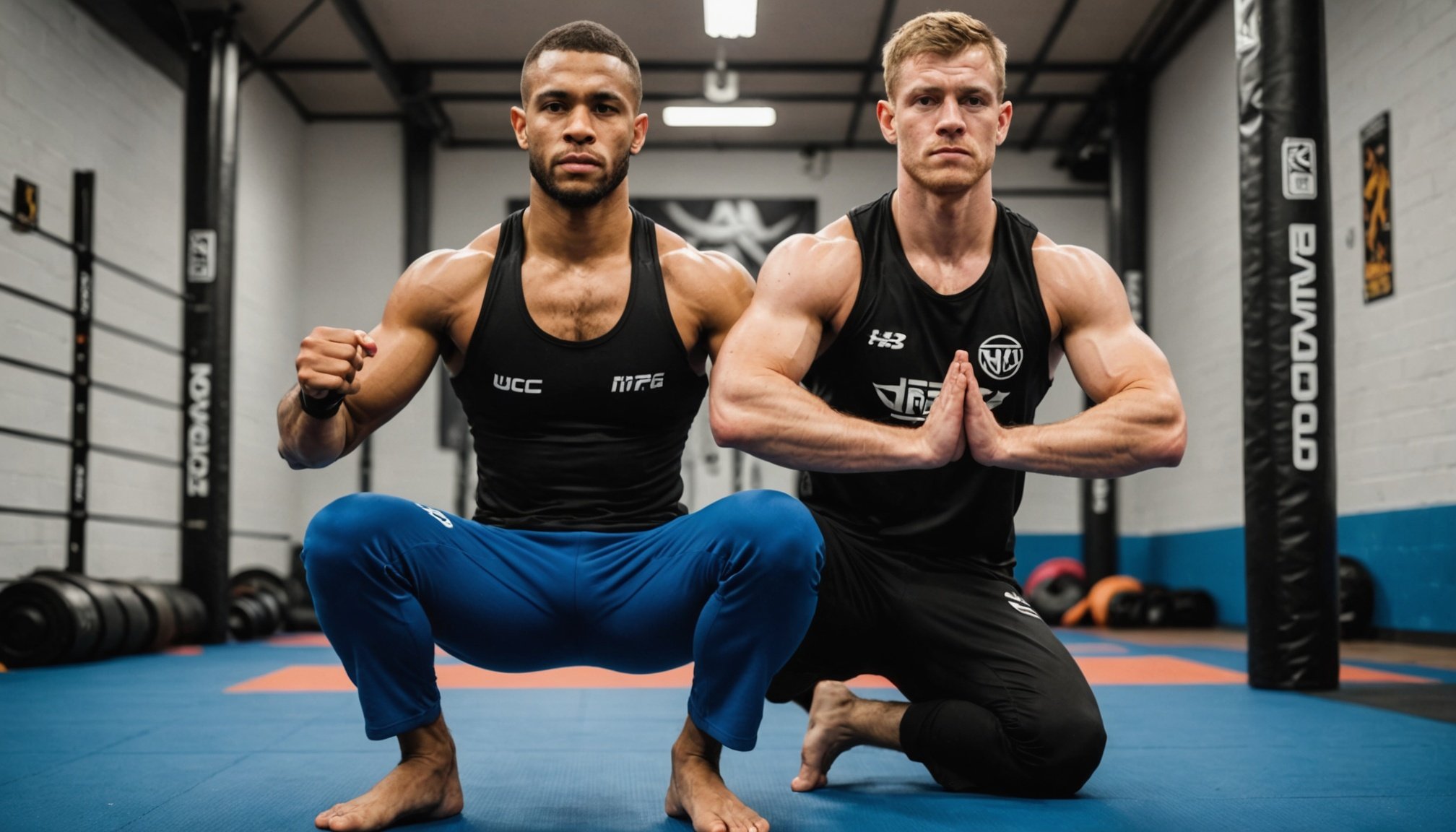Benefits of Yoga for MMA Fighters
MMA fighters constantly seek ways to improve physical conditioning and gain a competitive edge. Integrating yoga into their routines offers numerous advantages. One notable benefit is enhanced flexibility, which plays a pivotal role in both performance and injury prevention. Increasing flexibility allows fighters to move more fluidly and execute techniques with greater efficiency. This flexibility also reduces the likelihood of injuries, especially in high-impact scenarios where muscle strain and joint overload are prevalent.
Furthermore, yoga significantly boosts mental focus. In the fiercely competitive environment of MMA, having a sharp, clear, and focused mind can make the difference between victory and defeat. Through practices like mindfulness and meditation, yoga helps fighters achieve improved mental clarity. This translates into better strategic thinking, calmness under pressure, and a heightened ability to anticipate opponents’ moves.
This might interest you : How can martial artists effectively transition between different fighting styles?
Additionally, yoga enhances strength and endurance. Contrary to popular belief, yoga involves strength-building poses that engage muscles throughout the body. Practitioners develop greater body awareness, contributing to improved balance and coordination. This comprehensive approach ensures fighters maintain peak performance levels for more extended periods, both in training and during fights.
Incorporating yoga delivers these multifaceted benefits, propelling MMA fighters toward their goals.
Also read : Ultimate guide to off-season nutrition: key dietary tips for uk boxers
Key Yoga Poses for MMA Training
To enhance fighter fitness and improve movement patterns crucial for Mixed Martial Arts (MMA), integrating essential yoga poses is highly beneficial.
Downward Facing Dog
This foundational pose stretches the entire body, enhancing flexibility and strength. It’s particularly valuable for increasing hamstring and shoulder mobility, crucial for efficiently executing movement patterns in MMA. Beginners can bend the knees slightly to ease into the posture, while advanced practitioners can hold the pose longer to deepen the stretch. Incorporating it into warm-up routines can significantly improve fighter fitness by promoting blood circulation.
Warrior II
Warrior II is excellent for building leg strength and stability, which are essential yoga poses benefits. It enhances core endurance and focus, vital for maintaining stance in MMA fights. Adjusting the distance between the legs can cater to various skill levels, ensuring safe alignment. This pose complements MMA training by developing balance and mental tenacity.
Pigeon Pose
A pose that addresses hip flexibility, the Pigeon Pose helps in relieving tension and improving ground movement fluidity, facilitating better grappling techniques. Modifications, such as using a bolster, can assist those with tighter hips, ensuring a safe practice. Integrating it with stretching routines enhances recovery and flexibility.
These yoga poses strengthen the union between mind and body, facilitating robust performance enhancements in MMA.
Real Experiences from UK MMA Fighters
MMA fighters often share their personal stories about how integrating yoga into their training routine has led to noticeable performance improvements. One fighter recounted that adding yoga sessions helped increase flexibility and reduce the risk of injury, providing a crucial edge in their demanding sport. This anecdotal evidence highlights the mental and physical benefits that fighters experience.
Fighters have also offered personal testimonials on the broader mental impacts of yoga. They often cite increased focus and emotional resilience as key benefits—critical traits needed in high-stakes competition. By weaving yoga into their regimen, they report feeling more grounded and capable of managing the pressures that come with fighting professionally.
In terms of the preference for specific yoga styles, many MMA fighters favour types like Ashtanga or Vinyasa. These styles promote strength and flexibility, aligning well with the fighters’ training needs. It’s not uncommon for these athletes to appreciate the dynamic flow of Vinyasa yoga, as it mirrors the fluidity required in the octagon.
Through these authentic stories, UK MMA fighters illustrate how integrating yoga can be a game-changer, offering both practical and psychological advantages. Their experiences reinforce the potential of yoga as a valuable tool for enhancing performance.
Expert Opinions on Yoga in Combat Sports
Interviews with certified yoga instructors and sports psychologists reveal profound insights into how yoga complements martial arts training. Many experts emphasize that yoga and sports science collaborate to enhance physical and mental agility, which is crucial for combat athletes. According to a professional yoga instructor, yoga not only boosts flexibility but also plays a critical role in injury prevention by improving body alignment.
Sports psychologists underline the psychological benefits, noting that yoga promotes mental clarity, focus, and resilience—essential components for a successful martial artist. The integration of mindfulness and breath control found in yoga can be pivotal in controlling emotions and stress during competitions.
When compared to other training modalities like Pilates and Tai Chi, yoga stands out for its comprehensive approach. While Pilates emphasizes core strength and Tai Chi promotes balance and smooth movements, yoga incorporates these benefits and adds a layer of mindfulness practice. The holistic nature of yoga enables athletes to recover faster and maintain peak performance levels.
In conclusion, expert insights suggest that yoga is not just a supplementary activity but a fundamental component of a well-rounded martial arts training programme. By integrating yoga into their routines, athletes may discover improved performance, enhanced flexibility, and sharper mental focus.
Developing a Yoga-infused MMA Training Routine
Merging the disciplines of yoga with MMA preparation can enrich a fighter’s experience and enhance performance. Establishing a comprehensive training routine that incorporates yoga into MMA requires attentive structuring and commitment. Here’s how to create an effective regimen.
Sample Weekly Schedule
Crafting a balanced weekly training routine is vital. Consider mixing traditional MMA drills with yoga sessions:
- Monday: MMA techniques and 30-minute post-training yoga
- Wednesday: Sparring with restorative yoga in the evening
- Friday: Conditioning exercises followed by meditation-focused yoga
- Sunday: Active rest, prioritising flexibility with a gentle yoga class
This hybrid approach refreshes the body while sharpening focus and flexibility.
Importance of Consistency
Consistency is a cornerstone of success in any sport. Integrating yoga into an MMA preparation entails regularly practising both disciplines. The routine itself becomes an anchor, fostering discipline and supporting sustained progress. Consistent practice aids in cementing skills while promoting overall wellness.
Tracking Progress
Assessing progress is crucial in refining your training. You can track performance through:
- Setting personal goals and comparing results over time
- Maintaining a workout journal to log sessions and development
- Regular performance reviews to adjust the routine as needed
Integrating yoga with MMA can thus be a dynamic and rewarding journey, sharpening both the physical and mental edge of athletes.
Resources and Class Recommendations
For those seeking to enhance their yoga practice, exploring local yoga classes and workshops can be incredibly beneficial. The UK boasts a rich tapestry of yoga studios that cater to varying styles and preferences. Notable mentions include Triyoga in London and Pure Yoga Cheshire. These studios offer classes for all experience levels, from beginners to advanced practitioners.
For MMA fighters looking to incorporate yoga into their training regimen, online platforms provide excellent resources. Websites like Yoga for Fighters and MyYogaWorks offer specialized courses tailored to the needs of martial artists. These platforms provide flexibility in scheduling, allowing fighters to practice yoga at their convenience, which can greatly aid in improving flexibility, mental focus, and injury prevention.
Additionally, engaging with recommended readings can deepen your understanding of yoga’s impact on physical and mental well-being. Books such as “Light on Yoga” by B.K.S. Iyengar and “Yoga Anatomy” by Leslie Kaminoff are invaluable resources. They offer insights into both the philosophy and the physical dynamics of yoga practice.
By utilizing these resources, participants can not only improve their practice but also gain a comprehensive understanding of how yoga classes and workshops can enhance their overall well-being and performance in sports like MMA.










